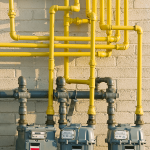Sustainable Energy Matters
You may have heard the word sustainable before. Do you know what it means, and why it matters?
 “Sustainable” means “having the ability to continue.” A sustainable world is one where energy and other resources are used in ways that allow the earth to continue as a safe and healthy home for humans, plants, and animals.
“Sustainable” means “having the ability to continue.” A sustainable world is one where energy and other resources are used in ways that allow the earth to continue as a safe and healthy home for humans, plants, and animals.
Using energy sustainably now will ensure we can continue to use it in the future without running out of our energy supplies or damaging the environment. This is one of the most important things we can do to keep our planet healthy and preserve the earth’s resources for ourselves and for future generations.
Energy in Your Life
You are constantly using energy. Think about it: Did you use hot water or electric lights today? Did you talk on a cell phone, or text someone? How was your food cooked? Energy helped make all these things happen.
So where does the energy you use come from?
 Natural gas and electricity are the forms of energy that people use most often in their homes, schools, and businesses. Natural gas is found deep underground and delivered to buildings through underground pipes.
Natural gas and electricity are the forms of energy that people use most often in their homes, schools, and businesses. Natural gas is found deep underground and delivered to buildings through underground pipes.
Electricity is a little more complicated. Whenever you use anything that runs on electricity, a power plant is most likely generating that electricity from nuclear power or fossil fuels (coal, oil, and natural gas).
 Fossil fuels and nuclear energy are nonrenewable resources, which means that once we use them up, they are gone forever. We can make these resources last longer by conserving energy and not wasting it, and by using energy from renewable resources that will not run out, such as the sun, wind, and moving water. You or someone you know is probably already using electricity made from solar panels, wind turbines, or a hydroelectric plant!
Fossil fuels and nuclear energy are nonrenewable resources, which means that once we use them up, they are gone forever. We can make these resources last longer by conserving energy and not wasting it, and by using energy from renewable resources that will not run out, such as the sun, wind, and moving water. You or someone you know is probably already using electricity made from solar panels, wind turbines, or a hydroelectric plant!
Energy and the Environment
No matter where your energy comes from, using it sustainably helps keep the environment healthy. This is because all energy production and use affects the environment. Here’s how:
 Burning fossil fuels for energy to power our homes and run our vehicles releases pollutants into the air and adds CO2 emissions to the atmosphere. Because fossil fuels are found deep underground, mining and transporting them can cause air and water pollution and disrupt local ecosystems.
Burning fossil fuels for energy to power our homes and run our vehicles releases pollutants into the air and adds CO2 emissions to the atmosphere. Because fossil fuels are found deep underground, mining and transporting them can cause air and water pollution and disrupt local ecosystems.- Using nuclear power to generate electricity produces no CO2 emissions. However, the uranium that is used to create nuclear energy becomes more radioactive after it is used, and remains radioactive for thousands and thousands of years. It must be stored safely so it does not harm living things. Finding safe storage sites can be difficult.
 Renewable energy sources such as biomass, wind power, solar power,hydropower can be used to make electricity and are generally better for the environment, but also pose some challenges. For example, growing crops for electricity production (biomass) may reduce crops used as food for humans or livestock. Dams for hydropower can affect water quality, river flows, and fish migration. And wind turbines can harm flying birds.
Renewable energy sources such as biomass, wind power, solar power,hydropower can be used to make electricity and are generally better for the environment, but also pose some challenges. For example, growing crops for electricity production (biomass) may reduce crops used as food for humans or livestock. Dams for hydropower can affect water quality, river flows, and fish migration. And wind turbines can harm flying birds.
When you use energy sustainably, you help control pollution, reduce CO2 emissions, and preserve our energy resources. You also help conserve other types of resources. It takes a tremendous amount of natural resources (like water, land, wood, and other building materials) to build a power plant. Saving energy delays the need for new power plants and helps conserve these resources for future generations.
Change Your Footprint
It’s impossible to change your fingerprints, but you can change your footprint—your carbon footprint, that is!
 Your carbon footprint is the amount of carbon dioxide (CO2) that is released to the atmosphere as a result of the energy used for your everyday activities. The food you eat, what you buy, and what you throw away all affect your carbon footprint. That’s because it takes energy to manufacture, package, and transport everything that you eat or use.
Your carbon footprint is the amount of carbon dioxide (CO2) that is released to the atmosphere as a result of the energy used for your everyday activities. The food you eat, what you buy, and what you throw away all affect your carbon footprint. That’s because it takes energy to manufacture, package, and transport everything that you eat or use.
Why change your carbon footprint? Many scientists believe that the CO2 in our atmosphere is increasing as a result of human activities, including the burning of fossil fuels for energy. Extra CO2 traps heat in the atmosphere, causing the earth to become warmer.
Because all of the earth’s natural processes are tied to temperature, some scientists are concerned that the warming of the earth is changing its climates and harming its ecosystems. Reducing your carbon footprint can help reduce the CO2 in the atmosphere and keep the earth healthy.
You can reduce your carbon footprint by:
- Using energy wisely at home and at school.
- Using electricity from renewable energy sources that produce less CO2.
- Making daily choices that protect the environment.
Sustainable Environment
What do an office building, a potato chip plant, and a train station have in common? They all include new technology that uses energy and other resources sustainably.
 An office building in Waltham, Massachusetts, saves hundreds of thousands of pounds of CO2 and millions of gallons of water per year! National Grid’s corporate center has solar panels on the rooftop, energy-efficient lighting, water-saving fixtures, and recycled furniture and floors. This building earned an international award for energy-efficient construction inside and out.
An office building in Waltham, Massachusetts, saves hundreds of thousands of pounds of CO2 and millions of gallons of water per year! National Grid’s corporate center has solar panels on the rooftop, energy-efficient lighting, water-saving fixtures, and recycled furniture and floors. This building earned an international award for energy-efficient construction inside and out.
 A potato chip manufacturing plant in Casa Grande, Arizona, runs mostly on solar power and recycles water from potatoes. Frito Lay’s plant uses special solar concentrators to heat water into steam to turn a turbine or cook the potatoes. It reuses the water from fresh potatoes to clean other potatoes. And the potato chips are packaged into compostable bags.
A potato chip manufacturing plant in Casa Grande, Arizona, runs mostly on solar power and recycles water from potatoes. Frito Lay’s plant uses special solar concentrators to heat water into steam to turn a turbine or cook the potatoes. It reuses the water from fresh potatoes to clean other potatoes. And the potato chips are packaged into compostable bags.
 A Tokyo train station uses special floor tiles to harness energy from people passing through ticket gates. The East Japan Railway Company installed piezoelectric tiles to convert the kinetic energy from millions of commuters’ footsteps into 1400 kW of electricity each day. The electricity is used to power the station’s electronic signs, lights, and ticket gates.
A Tokyo train station uses special floor tiles to harness energy from people passing through ticket gates. The East Japan Railway Company installed piezoelectric tiles to convert the kinetic energy from millions of commuters’ footsteps into 1400 kW of electricity each day. The electricity is used to power the station’s electronic signs, lights, and ticket gates.


